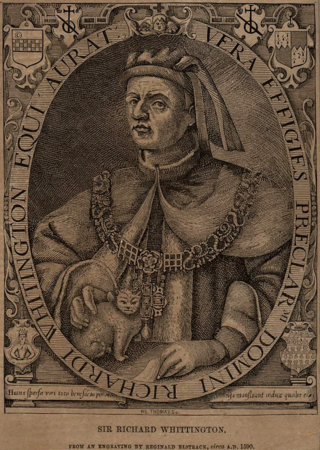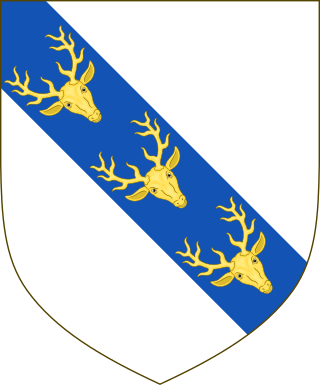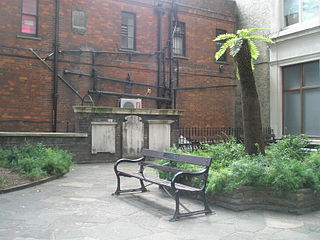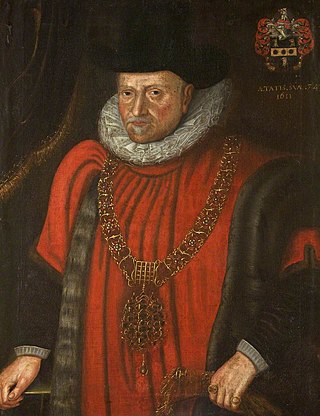Related Research Articles

Richard Whittington of the parish of St Michael Paternoster Royal, City of London, was an English merchant and a politician of the late medieval period. He is also the real-life inspiration for the English folk tale Dick Whittington and His Cat. He was four times Lord Mayor of London, a member of parliament and a Sheriff of London. In his lifetime he financed a number of public projects, such as drainage systems in poor areas of medieval London, and a hospital ward for unmarried mothers. He bequeathed his fortune to form the Charity of Sir Richard Whittington which, nearly 600 years later, continues to assist people in need.
Cripplegate was a gate in the London Wall which once enclosed the City of London.

Sir John Stanley, KG of Lathom, near Ormskirk in Lancashire, was Lord Lieutenant of Ireland and titular King of Mann, the first of that name. He married a wealthy heiress, Isabel Lathom, which, combined with his own great abilities, allowed him to rise above the usual status of a younger son.

Sir Gilbert Heathcote, 1st Baronet, was a British merchant and Whig politician who sat in the English and British House of Commons between 1701 and 1733. He was a Governor of the Bank of England and was Lord Mayor of London in 1711.
Thomas Fauconberg or Thomas Neville, sometimes called Thomas the Bastard, or the Bastard of Fauconberg, was the natural son of William Neville, Lord Fauconberg, who was a leading commander in the Hundred Years' War and, until joining his cousin, Richard Neville in rebellion on the Lancastrian side against another cousin, Edward IV, served on the Yorkist side in the Wars of the Roses.
Events from the 1400s in England.

Coleman Street is one of the 25 ancient wards of the City of London and lies on the City's northern boundary with the London Borough of Islington.

St Peter, Westcheap, also called "St Peter Cheap", "St Peter at the Cross in Cheap", or "Ecclesia S. Petri de Wodestreet", was a parish and parish church of medieval origins in the City of London. The church stood at the south-west corner of Wood Street where it opens onto Cheapside, directly facing the old Cheapside Cross. In its heyday it was a familiar landmark where the City waits used to stand on the roof and play as the great processions went past. It was destroyed in the Great Fire of London in 1666, together with most of its surroundings, and was never rebuilt.

Sir John Robinson, 1st Baronet, of London was an English merchant and politician who sat in the House of Commons between 1660 and 1667. He was Lord Mayor of London in 1662.

Sir Thomas Cambell was an English merchant who was Lord Mayor of London in 1609.

Thomas Canynges was an English politician who served as Lord Mayor of London from 1456 to 1457.
William Sevenoke was a grocer and politician who served as Mayor of London in 1418, and as warden of London Bridge, alderman of Bishopsgate Ward, alderman of Tower Ward, Warden of the Grocers' Company, Sheriff of London, Member of Parliament for the City of London and Surveyor of the King's works at Isleworth.
Sir Robert Chichele was a 15th-century English merchant and Lord Mayor of London.

Sir William Gore was Lord Mayor of London from 1701-02, having been elected Alderman for the City Ward of Coleman Street in 1690.
Sir John Cockayne was an English soldier, politician and landowner whose wealth made him a major force in the affairs of Derbyshire under the House of Lancaster. After numerous acts of criminality in concert with other Midlands landowners, he became a member of the Lancastrian affinity centred on John of Gaunt and a supporter of Henry IV. He fought in two campaigns of the Hundred Years War but his violence and lawlessness continued and he was decidedly out of favour during the reign of Henry V. With power less concentrated in the early years of Henry VI, he was able to serve three terms as High Sheriff of Nottinghamshire, Derbyshire and the Royal Forests and to wield considerable power and influence. He represented Derbyshire no less than nine times and Warwickshire twice in the House of Commons of England.

Sir Nicholas Exton was a medieval English merchant. A leading member of the Fishmongers' Company and citizen of the City of London, he was twice elected Mayor of that city during the troubled years of the reign of King Richard II. Little is known of his personal background and youth, but he became known at some point as a vigorous defender of the rights of his Guild. This eventually landed him in some trouble for attacking the then-current Mayor, and he was fined and imprisoned as a result. The situation soon reverted to his favour with the election as Mayor of Nicholas Brembre, a close ally of his. During this period Brembre was a loyal supporter of the King, who at this time was engaged in a bitter conflict with some of his nobles. They managed to manoeuvre the King into surrendering some of his authority, and this, in turn, weakened Brembre, who was eventually executed by the Appellants for his support of the King.
Adam Bamme was an English goldsmith and politician who served two non-consecutive terms as Lord Mayor of London in the 14th century.
John Hovyngham, also written Honyngham or Ovyngham, was an English clergyman, notary, diplomat and Archdeacon of Durham.
Sir Ralph Josselyn KB was a 15th-century English politician who held several political offices, including two terms as Lord Mayor of London.
John Hende was an English merchant and politician who served twice as Lord Mayor of London. He was imprisoned on the orders of King Richard II, before later becoming a leading financier of the reign of King Henry IV after Richard's overthrow.
References
- 1 2 3 4 5 "History of Parliament: Woodcock, John (d. 1409)
- ↑ Aldermen of the City of London: Coleman Street ward
- ↑ Aldermen of the City of London: Cripplegate ward
- ↑ De Laune, Thomas, "The Present State of London"
- ↑ Ackroyd, Peter, "Thames: The Biography", pg. 172
- ↑ Radulescu, Raluca, and Truelove, Alison, "Gentry Culture in Late-Medieval England", pp. 159-160
- ↑ Sutton, Anne F., "The Mercery of the City of London: Trade, Goods and People, 1130–1578"
- ↑ Woodcock, William Lee, "History of the Woodcock Family from 1692 to Sept. 1, 1912", pg. 14